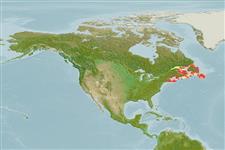Environment: milieu / climate zone / depth range / distribution range
Ecologia
marinhas bentopelágico. Temperate; 52°N - 41°N, 72°W - 47°W
Northwest Atlantic: northern Newfoundland (Strait of Belle Isle) in Canada to southern Massachusetts in USA.
Tamanho / Peso / Idade
Maturity: Lm ? range ? - ? cm
Max length : 18.0 cm TL macho/indeterminado; (Ref. 7251)
Found among algae on rocky shores and on hard bottom in deeper water, or depth of 55 meters or more (Ref. 51666). Male guards multiple egg masses (Ref. 58332).
Ciclo de vida ou comportamento de acasalamento
Maturities | Reprodução | Spawnings | Egg(s) | Fecundities | Larvas
Eggs are laid in several clumps or masses which are guarded by the male parent (Ref. 58332).
Robins, C.R. and G.C. Ray, 1986. A field guide to Atlantic coast fishes of North America. Houghton Mifflin Company, Boston, U.S.A. 354 p. (Ref. 7251)
Status na Lista Vermelha da UICN (Ref. 130435)
Ameaça para os humanos
Harmless
Uso pelos humanos
Ferramentas
Relatórios especiais
Baixar XML
Fontes da internet
Estimates based on models
Preferred temperature (Ref.
123201): 2.5 - 11.7, mean 6.4 °C (based on 72 cells).
Índice de diversidade filogenética (Ref.
82804): PD
50 = 1.0000 [Uniqueness, from 0.5 = low to 2.0 = high].
Bayesian length-weight: a=0.00380 (0.00165 - 0.00876), b=3.16 (2.96 - 3.36), in cm total length, based on LWR estimates for this (Sub)family-body shape (Ref.
93245).
Nível Trófico (Ref.
69278): 4.4 ±0.0 se; based on diet studies.
Resiliência (Ref.
120179): médio(a), tempo mínimo de duplicação da população 1,4 - 4,4 anos (K=0.19-0.22; tmax=10).
Fishing Vulnerability (Ref.
59153): Moderate vulnerability (40 of 100).
Nutrients (Ref.
124155): Calcium = 42 [20, 79] mg/100g; Iron = 0.259 [0.142, 0.493] mg/100g; Protein = 17.5 [16.4, 18.6] %; Omega3 = 0.488 [0.231, 0.983] g/100g; Selenium = 12.3 [4.7, 28.7] μg/100g; VitaminA = 51.6 [11.9, 221.8] μg/100g; Zinc = 0.696 [0.459, 1.048] mg/100g (wet weight);
